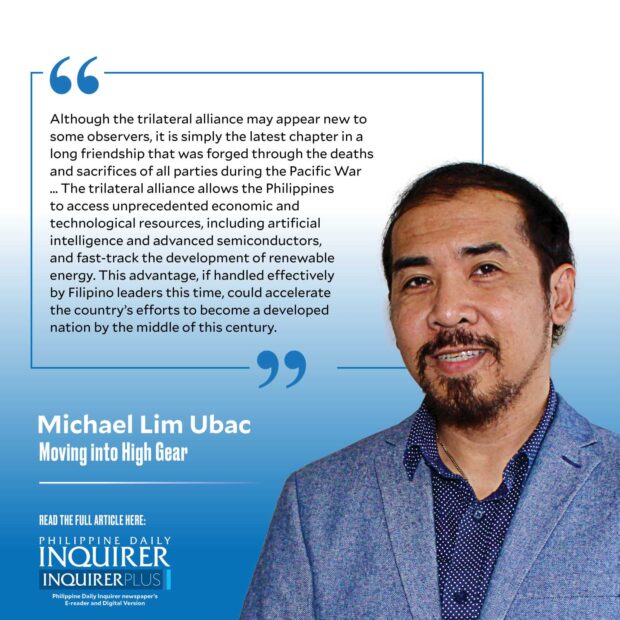Bataan’s fall and the rise of a trilateral alliance

The fall of Bataan took place 82 years ago last Tuesday, when American and Filipino soldiers surrendered to Japanese forces in World War II (WWII). This trio of countries, the United States, Philippines, and Japan, are now close allies.
Their friendship has led to the first-ever summit, scheduled today in Washington, of US President Joe Biden, Japanese Prime Minister Fumio Kishida, and Philippine President Ferdinand Marcos Jr. The optics of this high-level summit is unmistakably powerful: an upgrading of an alliance against a rising rival in the Indo-Pacific.
An Associated Press report said that Kishida “will emphasize that Japan and the US are now global partners working to maintain a rules-based international order, and that Japan is willing to take on a greater international role in security, economy, and space to help Washington.”
Article continues after this advertisementOn the part of the Philippines, the trilateral meeting is not “directed at any country,” but a “deepening of existing strong bilateral alliances that we have had,” the Department of Foreign Affairs said.
Although the trilateral alliance may appear new to some observers, it is simply the latest chapter in a long friendship that was forged through the deaths and sacrifices of all parties during the Pacific War.
Each year, we mark the anniversary of the fall of Bataan on April 9, 1942. The Araw ng Kagitingan (Day of Valor) is a reminder of the bravery of Filipinos and Americans who fought against the Japanese.
Article continues after this advertisementOn Mount Samat in Pilar, Bataan, there is the Dambana ng Kagitingan (Shrine of Valor) marked by a large white cross that can be seen from Manila Bay on a clear day. Every sitting president of the Philippines and the current US and Japanese ambassadors to the Philippines make the trek to Mount Samat on April 9 every year, a solemn ritual that is made poignant by the presence of surviving Filipino war veterans whose numbers are dwindling every year.
Renewal of vows. The yearly ritual is akin to a renewal of vows among these three allies—that they never again would kill each other, placing their common goals of mutual prosperity and peace at the heart of the alliance. It is significant that Japan, the villain of WWII, has pledged allegiance to this friendship, which represents a sea change in its worldview from imperialistic to pacifist (peace-loving) modern nation.
The alliance becomes more strategic since both the US and Japan are among the top three largest economies in the world. The trilateral alliance allows the Philippines to access unprecedented economic and technological resources, including artificial intelligence and advanced semiconductors, and fast-track the development of renewable energy. This advantage, if handled effectively by Filipino leaders this time, could accelerate the country’s efforts to become a developed nation by the middle of this century.
For sure, the friendship between the three countries came at a dear cost to Imperial Japan after its campaign of atrocity, including the invasion of the Philippines. At the end of WWII in 1945, a B-29 Superfortress bomber named Enola Gay dropped the first of the two atomic bombs, which incinerated the Japanese cities of Hiroshima and Nagasaki. This was the only time that nuclear weapons were ever used in warfare.
It dealt a death knell to Imperial Japan, which had attacked Pearl Harbor on Dec. 7, 1941. That “date which will live in infamy,” according to US President Franklin D. Roosevelt, forced the initially reluctant America to enter WWII. The rest is history.
Fighting for freedom. It has been often said that history is written by the victors, but the victors often forget about the contributions of smaller players, which are just as significant.
During Japan’s short occupation of the Philippines in WWII, Filipino guerillas and some 70,000 Filipino-Americans of the 1st and 2nd Infantry Regiments worked together secretly to fight the Asian power. They provided intelligence reports to Allied powers and guerillas ambushed the occupiers behind enemy lines.
Inquirer’s longtime correspondent Tonette T. Orejas reported about the newly released book, “Dauntless,” written by Marie Silva Vallejo. (Access the story at: https://tinyurl.com/597bwz72.) The Philippine Regional Section sent 20 submarines for 41 missions, delivering 1,627 tons of men, radio, weapons, supplies, and propaganda to the Philippines. Their contributions prepared the way for the return of US Army Gen. Douglas MacArthur who escaped to Australia before Bataan fell to the Japanese forces.
By the time MacArthur, Sergio Osmeña, and Carlos P. Romulo waded ashore in Palo, Leyte, in 1944, the advanced regiments had already set up 134 radio stations—46 (Mindanao), 23 (Panay), 21 (Luzon), 13 (Negros), 11 (Leyte), six (Mindoro), five (Palawan), three each (Cebu and Samar), and one each (Bohol, Masbate, and Tawi-Tawi).
(More on WWII historical continuities in my next column.)
—————-
For comments: lim.mike04@gmail.com;
















